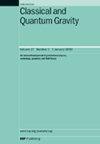由合并引发的类星体能解释nanogravity的随机引力波背景吗?
IF 3.6
3区 物理与天体物理
Q2 ASTRONOMY & ASTROPHYSICS
引用次数: 0
摘要
最近几次脉冲星定时阵列实验发现的随机引力波(GW)背景与一群合并的超大质量黑洞双星相一致。背景的振幅略高于大多数以前的人口模型或从局部质量密度观测得到的预期。这样的双星预计会在星系合并中产生,这也被认为会引发明亮的类星体活动。在假设(i)所有类星体中有一部分与合并有关,(ii)类星体的典型寿命为,以及(iii)类星体的光度采用Eddington比,我们计算了与经验测量的类星体光度函数直接相关的GW背景。这种方法绕过了通过模拟或半分析模型来模拟黑洞或星系合并的宇宙演化的需要。我们找到了与nanogravity测量值相匹配的振幅。我们的结果与大多数类星体与黑洞双星相关联并且是GW背景的来源一致,并且暗示了典型质量比和典型质量比的联合约束。在这种情况下,信号主要来自相对较远的源,在类星体活动的高峰期。与其他模型类似,我们的结果仍然与局部超大质量黑洞的质量密度相矛盾。本文章由计算机程序翻译,如有差异,请以英文原文为准。
Can quasars, triggered by mergers, account for NANOGrav’s stochastic gravitational wave background?
The stochastic gravitational wave (GW) background recently discovered by several pulsar timing array experiments is consistent with arising from a population of coalescing super-massive black hole binaries. The amplitude of the background is somewhat higher than expected in most previous population models or from the local mass density observations. Such binaries are expected to be produced in galaxy mergers, which are also thought to trigger bright quasar activity. Under the assumptions that (i) a fraction of all quasars are associated with mergers, (ii) the typical quasar lifetime is , and (iii) adopting Eddington ratios for the luminosity of quasars, we compute the GW background associated directly with the empirically measured quasar luminosity function. This approach bypasses the need to model the cosmological evolution of black holes or galaxy mergers from simulations or semi-analytical models. We find the amplitude matching the value measured by NANOGrav. Our results are consistent with most quasars being associated with black hole binaries and being the sources of the GW background, and imply a joint constraint on , and the typical mass ratio . The signal in this case would be dominated by relatively distant sources at , at the peak of quasar activity. Similarly to other models, our results remain in tension with the local super-massive black hole mass density.
求助全文
通过发布文献求助,成功后即可免费获取论文全文。
去求助
来源期刊

Classical and Quantum Gravity
物理-天文与天体物理
CiteScore
7.00
自引率
8.60%
发文量
301
审稿时长
2-4 weeks
期刊介绍:
Classical and Quantum Gravity is an established journal for physicists, mathematicians and cosmologists in the fields of gravitation and the theory of spacetime. The journal is now the acknowledged world leader in classical relativity and all areas of quantum gravity.
 求助内容:
求助内容: 应助结果提醒方式:
应助结果提醒方式:


